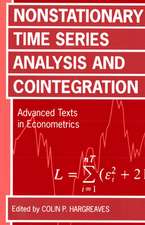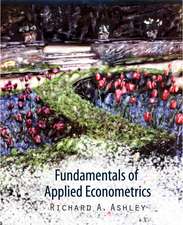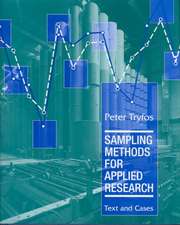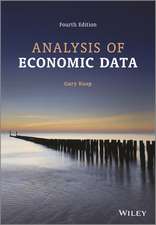The Measurement of Economic Relationships: Advanced Studies in Theoretical and Applied Econometrics, cartea 41
Autor Peter Tryfosen Limba Engleză Hardback – 20 dec 2004
| Toate formatele și edițiile | Preț | Express |
|---|---|---|
| Paperback (1) | 634.00 lei 6-8 săpt. | |
| Springer Us – 19 noi 2010 | 634.00 lei 6-8 săpt. | |
| Hardback (1) | 640.06 lei 6-8 săpt. | |
| Springer Us – 20 dec 2004 | 640.06 lei 6-8 săpt. |
Din seria Advanced Studies in Theoretical and Applied Econometrics
- 20%
 Preț: 568.81 lei
Preț: 568.81 lei - 20%
 Preț: 817.34 lei
Preț: 817.34 lei - 24%
 Preț: 793.66 lei
Preț: 793.66 lei - 15%
 Preț: 640.06 lei
Preț: 640.06 lei -
 Preț: 383.12 lei
Preț: 383.12 lei - 18%
 Preț: 1222.62 lei
Preț: 1222.62 lei - 18%
 Preț: 950.33 lei
Preț: 950.33 lei - 18%
 Preț: 950.03 lei
Preț: 950.03 lei - 15%
 Preț: 637.41 lei
Preț: 637.41 lei - 15%
 Preț: 645.79 lei
Preț: 645.79 lei -
 Preț: 387.38 lei
Preț: 387.38 lei - 18%
 Preț: 945.30 lei
Preț: 945.30 lei - 18%
 Preț: 949.73 lei
Preț: 949.73 lei -
 Preț: 386.22 lei
Preț: 386.22 lei - 18%
 Preț: 949.73 lei
Preț: 949.73 lei - 18%
 Preț: 952.40 lei
Preț: 952.40 lei - 18%
 Preț: 945.47 lei
Preț: 945.47 lei - 18%
 Preț: 954.45 lei
Preț: 954.45 lei - 18%
 Preț: 947.35 lei
Preț: 947.35 lei - 15%
 Preț: 645.60 lei
Preț: 645.60 lei - 18%
 Preț: 975.43 lei
Preț: 975.43 lei - 18%
 Preț: 1226.24 lei
Preț: 1226.24 lei -
 Preț: 392.60 lei
Preț: 392.60 lei - 15%
 Preț: 632.22 lei
Preț: 632.22 lei -
 Preț: 382.36 lei
Preț: 382.36 lei - 15%
 Preț: 642.18 lei
Preț: 642.18 lei - 18%
 Preț: 951.59 lei
Preț: 951.59 lei
Preț: 640.06 lei
Preț vechi: 753.01 lei
-15% Nou
Puncte Express: 960
Preț estimativ în valută:
122.47€ • 128.22$ • 101.34£
122.47€ • 128.22$ • 101.34£
Carte tipărită la comandă
Livrare economică 05-19 aprilie
Preluare comenzi: 021 569.72.76
Specificații
ISBN-13: 9781402028380
ISBN-10: 1402028385
Pagini: 164
Ilustrații: XIV, 148 p.
Dimensiuni: 156 x 234 x 15 mm
Greutate: 0.41 kg
Ediția:2004
Editura: Springer Us
Colecția Springer
Seria Advanced Studies in Theoretical and Applied Econometrics
Locul publicării:New York, NY, United States
ISBN-10: 1402028385
Pagini: 164
Ilustrații: XIV, 148 p.
Dimensiuni: 156 x 234 x 15 mm
Greutate: 0.41 kg
Ediția:2004
Editura: Springer Us
Colecția Springer
Seria Advanced Studies in Theoretical and Applied Econometrics
Locul publicării:New York, NY, United States
Public țintă
Professional/practitionerCuprins
1 Introduction.- 1.1 The Status Quo.- 1.2 The CLM in Academic Studies.- 1.3 The CLM in Practice.- 1.4 Extensions of the CLM.- 1.5 The Road Ahead.- 2 The Fitting Method: An Introduction.- 2.1 Introduction.- 2.2 The Problem.- 2.3 The Available Information.- 2.4 One Solution.- 2.5 Least Squares and Spreadsheets.- 2.6 Constrained Least Squares.- 2.7 Tolerance Intervals.- 2.8 Joint Tests and Tolerance Regions.- 2.9 Interval Forecasts.- 2.10 Computer Output.- 2.11 In Summary.- 3 The Fitting Method: A Formal Treatment.- 3.1 Introduction.- 3.2 Relationships.- 3.3 Unrestricted Least Squares.- 3.4 Restricted Least Squares.- 3.5 Ordinary Tolerance Intervals and Regions.- 3.6 A Tolerance Region for All Parameters.- 3.7 Tolerance Interval Forecasts.- 3.8 Possible Extensions.- 4 The Clasical Linear Model.- 4.1 Introduction.- 4.2 The Assumptions of the CLM.- 4.3 Estimates and Their Properties.- 4.4 Statistical Inference.- 4.5 Specification Error.- 4.6 On Confidence Interval Estimates.- 4.7 The Many Problems of Significance.- 4.8 On Confidence Interval Forecasts.- 4.9 The Art and Practice of Statistical Inference.- 4.10 Bad Practice or Bad Theory?.- 5 The Central Assumptions.- 5.1 Introduction.- 5.2 True Parameters?.- 5.3 The Randomness of Error.- 5.4 Probability.- 5.5 The Central Limit Theorem and Normality.- 5.6 Are the Unknown Factors Random Variables?.- 5.7 Serial Correlation.- 5.8 The “As If” Argument.- 5.9 A Probable Deviation.- 5.10 On the Distribution of Residuals.- 5.11 In Summary.- 6 Random Processes.- 6.1 Introduction.- 6.2 The Coin Toss.- 6.3 Of Births and Deaths.- 6.4 Stock Market Prices.- 6.5 Some Perils of Time Series Analysis.- 6.6 In Conclusion.- 7 The “Probabilistic Revolution”.- 7.1 Introduction.- 7.2 Before Haavelmo.- 7.3 Haavelmo on Relationships.- 7.4Haavelmo in Contemporary Reviews.- 7.5 The Probability Approach Reconsidered.- 7.6 Random Sampling.- 7.7 The Assumptions Reconsidered, Continuation.- 7.8 In Summary.- 8 Assessment.- 8.1 The Fitting Method in Perspective.- 8.2 The Tolerance Level.- 8.3 The Technical Pursuit of Fit.- 8.4 The Success Rate of Tolerance Interval Forecasts.- 8.5 The Poverty of Properties.- 8.6 Does It Matter?.- 8.7 Subjective Probability.- 8.8 Determinism and Probabilism.- 8.9 The “As If” Assumption Revisited.- 8.10 Why the Status Quo?.- 8.11 A Pragmatic Approach.- References.












